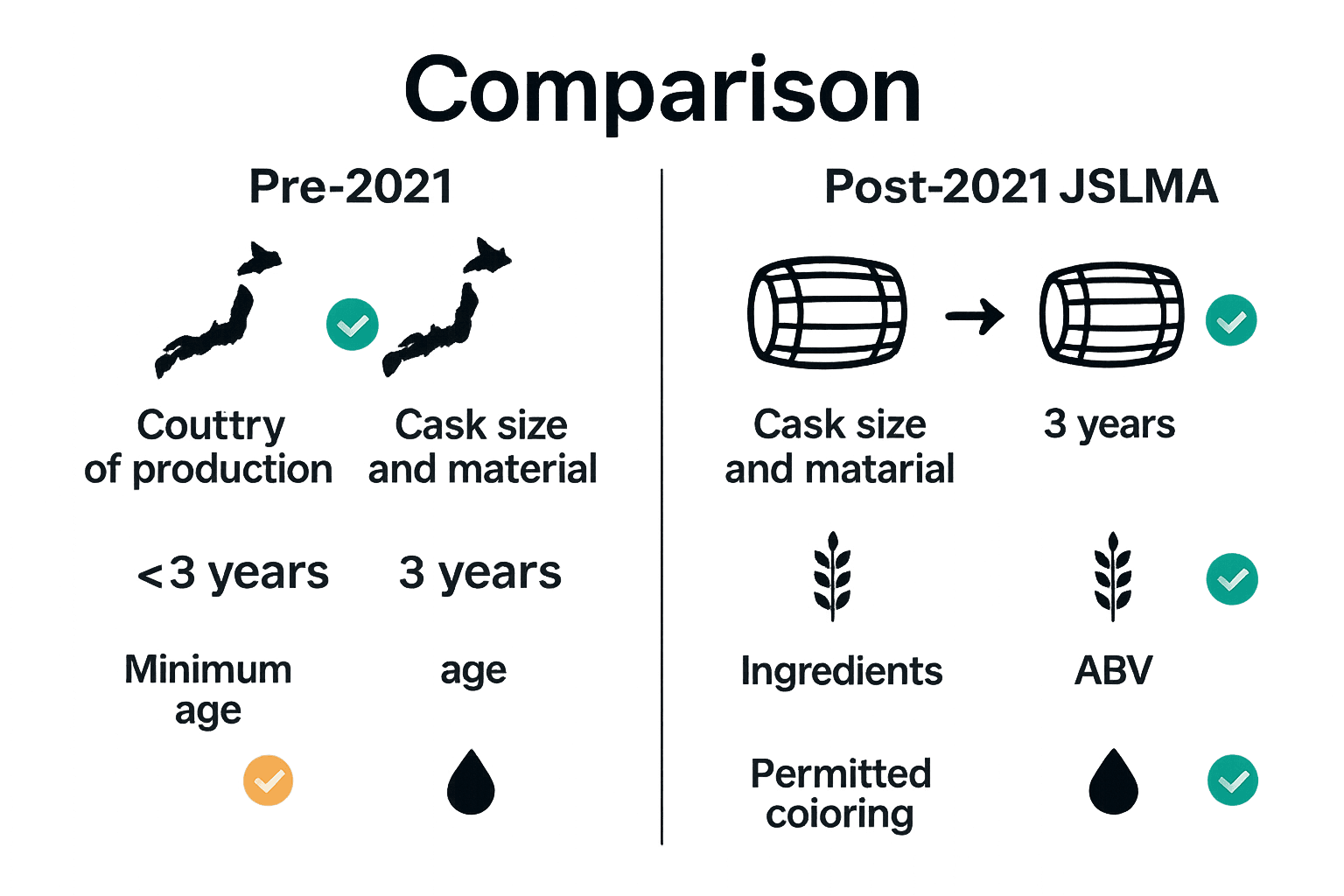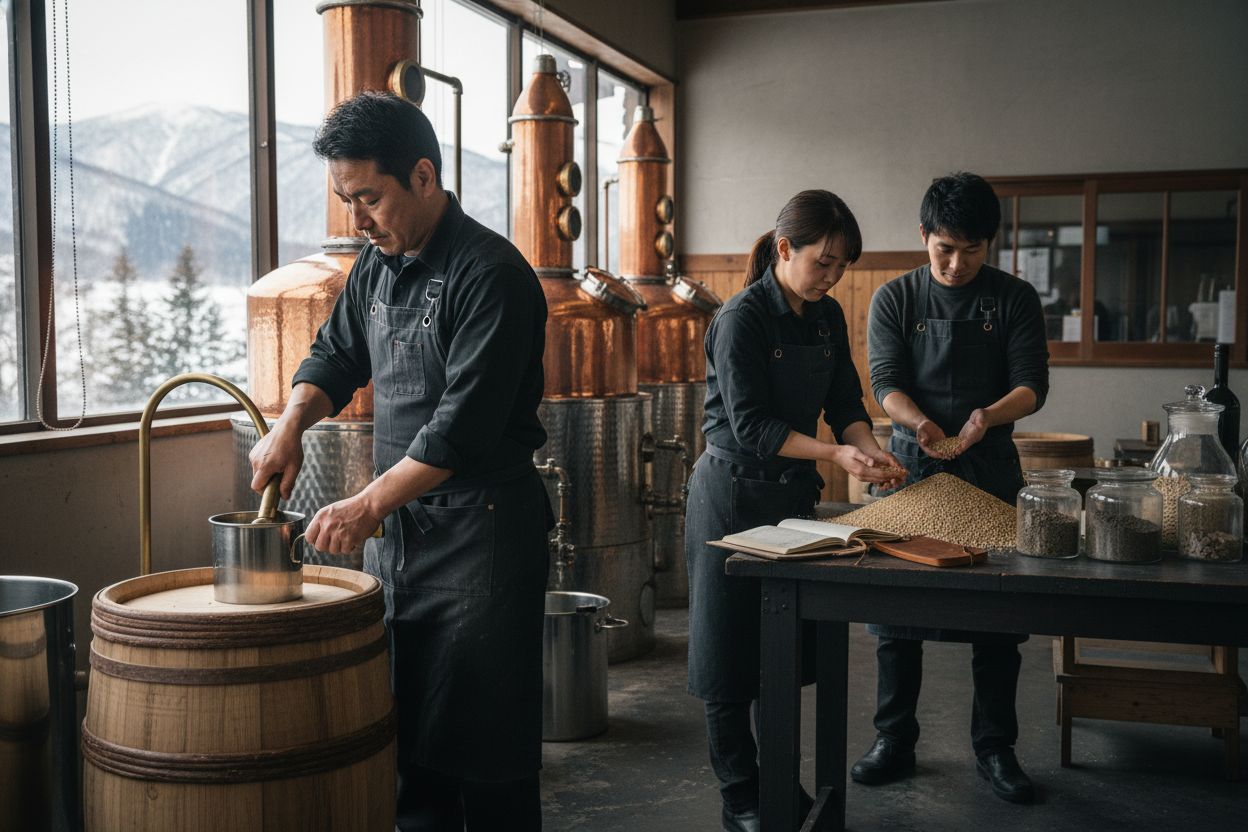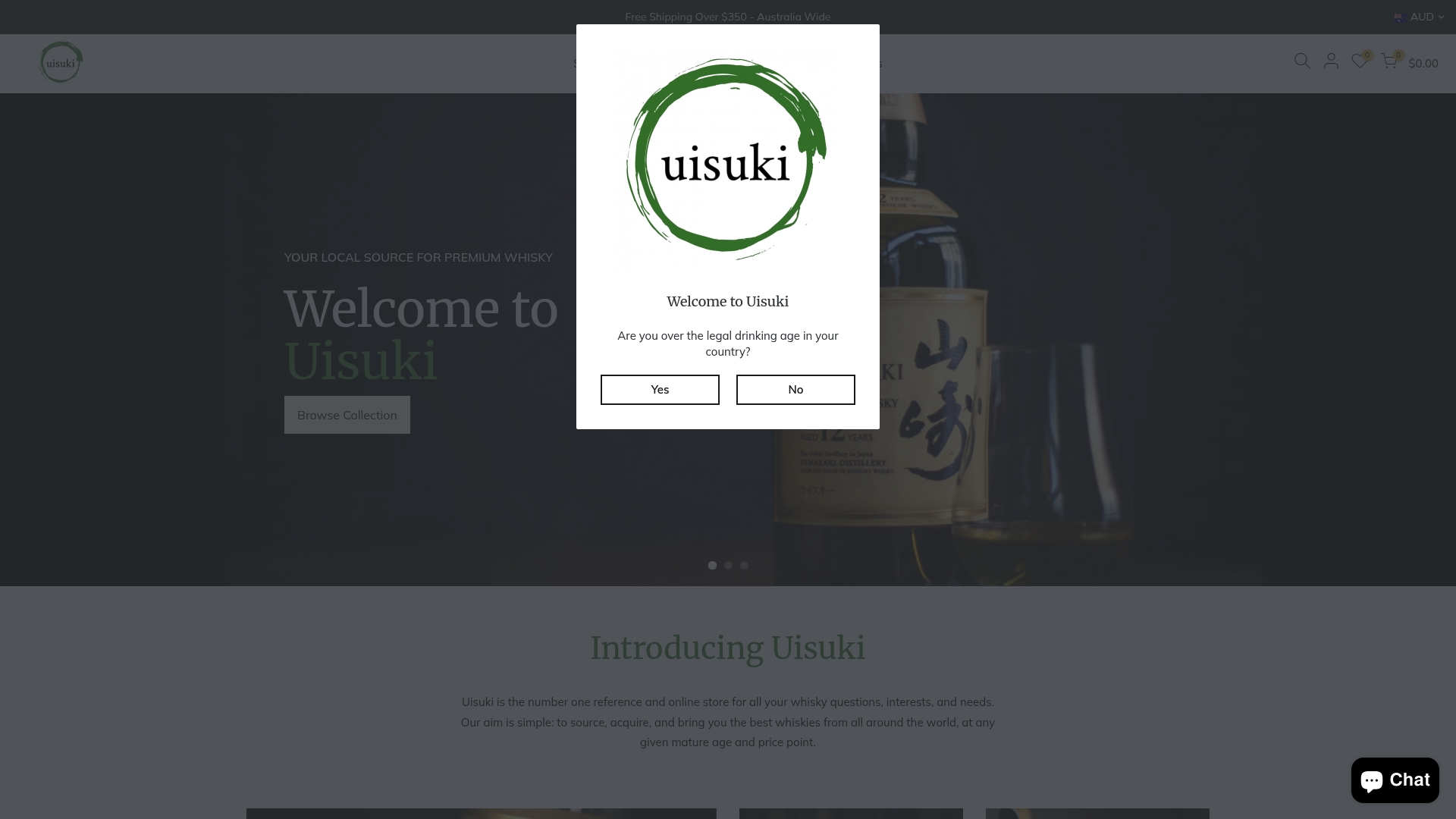Over the past decade, interest in Japanese whisky has soared, with exports rising by over 40 percent worldwide. Discerning drinkers and collectors are drawn to its strict authenticity standards, unique ingredients like Mizunara oak, and centuries-old craftsmanship. As new regulations reshape what truly defines Japanese whisky, connoisseurs now enjoy genuine bottles that showcase meticulous production methods and distinctive regional flavors, offering a taste experience unlike any other.
Key Takeaways
| Point | Details |
|---|---|
| Regulatory Standards | The introduction of strict JSLMA standards in 2021 enhances transparency and defines what constitutes authentic Japanese whisky, ensuring quality control. |
| Traditional & Unique Techniques | Japanese whisky blends Scottish methods with local ingredients, notably Mizunara oak, creating distinct flavor profiles that reflect regional characteristics. |
| Global Recognition | Japanese whisky has gained international acclaim for its craftsmanship, characterized by a commitment to subtlety and precision, distinguishing it from other whisky styles. |
| Investment Potential | The market for Japanese whisky has evolved into a lucrative investment category, with limited editions and authenticity becoming increasingly valuable to collectors and investors. |
Table of Contents
- What Defines Japanese Whisky Today
- Traditional Techniques And Unique Ingredients
- Signature Flavors And Distinctive Profiles
- How Japanese Whisky Compares Globally
- Collecting, Gifting, And Investment Insights
What Defines Japanese Whisky Today
In 2021, the Japanese whisky world underwent a significant transformation with the introduction of strict official standards by the Japan Spirits & Liqueurs Makers Association (JSLMA). These groundbreaking regulations fundamentally redefined what can be authentically labeled as “Japanese whisky,” bringing unprecedented transparency and quality control to the industry.
According to the JSLMA guidelines, a whisky can only be called “Japanese” if it meets several critical requirements:
- Fermentation and distillation must occur in Japan
- Aging must happen in wooden casks no larger than 700 litres for a minimum of three years
- Malted grains and water must be sourced from Japan
- Minimum alcohol content of 40% ABV
- Only plain caramel colouring is permitted
Prior to these standards, the Japanese whisky market was somewhat like the Wild West. Brands could import foreign whiskies, blend or bottle them in Japan, and market them as “Japanese” without genuine domestic production. The 7 Essential Japanese Whisky Styles guide provides deeper insights into how these new regulations impact traditional whisky production methods.
These regulations, which became fully enforceable by 2024, represent more than bureaucratic paperwork.
They’re a commitment to preserving the authenticity and reputation of Japanese whisky on the global stage, ensuring consumers receive a genuine, high-quality product that truly represents Japanese craftsmanship.
Here’s a comparison of key Japanese whisky production standards before and after the 2021 JSLMA regulations:

| Requirement | Pre-2021 (Old Rules) | Post-2021 JSLMA Standards |
|---|---|---|
| Production Location | Domestic or imported | Must be in Japan |
| Cask Size & Material | Not specified | Wooden casks ≤700L |
| Minimum Age | No minimum | At least 3 years |
| Ingredients | Global sourcing permitted | Japanese water & malted grain |
| Alcohol by Volume (ABV) | Variable | Minimum 40% ABV |
| Colour Additives | Unrestricted | Only plain caramel allowed |
Traditional Techniques and Unique Ingredients
Japanese whisky represents a remarkable fusion of traditional Scottish distillation methods and uniquely Japanese craftsmanship, creating a distinctive approach that sets it apart from other global whisky traditions. Mizunara oak, a rare and challenging wood native to Japan, plays a pivotal role in this distinctive character. Unlike standard oak casks, Mizunara imparts extraordinary flavour profiles featuring complex notes of oriental spices, delicate incense, and rich sandalwood—characteristics that cannot be replicated elsewhere.
According to research, craft distilleries like Akkeshi are pioneering a terroir-driven approach by leveraging local ingredients such as Hokkaido peat and indigenous malt. Their production methods closely mirror traditional pot still techniques reminiscent of Scottish Islay distilleries, yet they create something entirely unique. These distilleries focus on expressing regional character, producing distinctive peated expressions that capture the essence of their specific geographic environment.
The Yamazaki Distiller’s Reserve exemplifies this meticulous approach. Renowned distilleries like Hakushu and Chichibu further demonstrate how natural surroundings profoundly influence whisky production. Their whiskies are not merely beverages but liquid narratives of Japanese landscapes—each sip telling a story of meticulous craftsmanship, local ingredients, and generations of refined technique.
 The result is a whisky style that respects global traditions while asserting a proudly Japanese identity.
The result is a whisky style that respects global traditions while asserting a proudly Japanese identity.
Signature Flavors and Distinctive Profiles
Japanese whiskies are renowned for their exceptional subtlety and complexity, distinguishing themselves from other global whisky traditions through remarkably nuanced flavor profiles. Unlike robust Scotch whiskies, Japanese expressions typically feature a lighter body with delicate fruit notes and an elegant dry finish that showcases extraordinary refinement. These characteristics are profoundly influenced by regional microclimates and unique local water sources.
Take the legendary Yamazaki 25‑Year‑Old Mizunara as a quintessential example. When fully aged in native Mizunara oak casks, this whisky develops extraordinary sensory dimensions—roasted coconut intertwines with ethereal incense notes, while apricot-like sweetness creates a multilayered spice experience that epitomizes Japanese whisky craftsmanship. The 7 Essential Japanese Whisky Styles guide offers deeper insights into these remarkable flavor variations.
Climate plays a critical role in flavor development. Cooler Japanese regions produce refined, elegantly structured whiskies with restrained intensity, while warmer areas accelerate maturation, generating more pronounced and robust flavor profiles. This geographic diversity means each Japanese whisky tells a unique story—a liquid representation of its precise origin, reflecting the intricate relationship between environment, craftsmanship, and sensory experience. The result is a whisky style that is simultaneously traditional and innovative, inviting enthusiasts to explore a world of nuanced taste sensations.
How Japanese Whisky Compares Globally
Japanese whisky has carved a remarkable niche in the global spirits landscape, distinguished by its extraordinary craftsmanship and unique production philosophy. While stylistically closest to Scotch whisky, Japanese expressions distinguish themselves through an unparalleled commitment to precision and subtle innovation. Industry structure sets Japanese whisky apart—distilleries here are vertically integrated, meaning producers own both their brands and blending processes, a stark contrast to the more fragmented Scottish model.
The global reputation of Japanese whisky has grown exponentially since the early 2000s, with exports becoming a significant cultural and economic ambassador. Its lighter, more elegant profile—characterized by floral and fruity notes—offers a refined alternative to more robust whisky traditions. The Nikka Yoichi 15 Year Old Single Malt exemplifies this sophisticated approach, showcasing the delicate balance that has earned international acclaim.
Where Scottish whiskies offer intense peatiness and American bourbons present bold, sweet profiles, Japanese whiskies deliver a masterclass in subtlety. Their uniqueness stems from precise craftsmanship, Mizunara oak aging, and an almost meditative approach to spirit-making. This commitment has transformed Japanese whisky from a regional curiosity to a globally respected category, celebrated for its depth, complexity, and remarkable ability to surprise even the most experienced whisky enthusiasts.
Collecting, Gifting, and Investment Insights
Japanese whisky has transformed from a passionate collector’s niche into a serious investment category, with ultra-premium releases commanding extraordinary market value. Take the legendary Yamazaki 25‑Year‑Old Mizunara, which can fetch around USD 7,500—a testament to the remarkable craftsmanship and scarcity that drives collector interest. These bottles represent more than mere spirits; they’re liquid assets with potential for significant appreciation.
The recent JSLMA standards have dramatically enhanced the authenticity and investment appeal of Japanese whiskies. By implementing strict production guidelines, the industry has built unprecedented trust among collectors and investors. Limited editions from renowned distilleries become particularly valuable, with their unique regional characteristics and precise craftsmanship making them highly sought after. The 7 Essential Japanese Whisky Styles guide provides collectors with critical insights into identifying truly exceptional bottles.
When considering a Japanese whisky as a gift or investment, focus on several key factors: production method, age statement, distillery reputation, and rarity. Younger collectors are increasingly viewing these whiskies as alternative investment vehicles, appreciating not just their potential financial value, but the cultural narrative each bottle represents. Whether you’re a serious investor or someone seeking a memorable gift, Japanese whiskies offer a perfect blend of artistry, tradition, and potential long-term value.
Discover Genuine Japanese Whisky with Confidence at Uisuki
Many whisky enthusiasts today face real uncertainty about what counts as authentic Japanese whisky. This article showed how new JSLMA standards have raised the bar on transparency and craftsmanship. If you want to explore bottles that truly capture the unique taste, tradition and value of Japanese whisky, you need a retailer who understands and embraces these same high standards.

At Uisuki.com.au, you get more than just access to award-winning Japanese whiskies. You’ll find expertly curated collections that follow the latest industry definitions, in-depth product details so you know exactly what you’re buying, and a dedicated team ready to guide you. Looking to start or grow your collection? Our education hub can help you unlock rare expressions and investment-worthy releases. Make your next bottle purchase with absolute trust and enjoy a taste of real Japanese craftsmanship. Shop now and experience the difference of buying from Australia’s whisky specialists.
Frequently Asked Questions
What are the official standards for Japanese whisky?
Japanese whisky must meet specific standards, which include fermentation and distillation in Japan, aging in wooden casks for a minimum of three years, the use of Japanese water and malted grains, a minimum alcohol content of 40% ABV, and the allowance of only plain caramel coloring.
How does Japanese whisky differ from Scotch whisky?
While both Japanese and Scotch whiskies share some similarities, Japanese whisky is often lighter and more subtle, featuring floral and fruity notes. Additionally, Japanese distilleries typically employ a vertically integrated model, contrasting with the more fragmented structure of Scotch whisky production.
What role does Mizunara oak play in Japanese whisky?
Mizunara oak is a native wood in Japan that imparts unique flavor characteristics to whiskies, including notes of oriental spices, incense, and sandalwood. This cask wood is challenging to work with but significantly contributes to the whisky’s distinctive profile.
Why is Japanese whisky considered a good investment?
Japanese whisky, especially ultra-premium releases like the Yamazaki 25-Year-Old Mizunara, has significant market value due to its craftsmanship and scarcity. The JSLMA standards enhance trust in the quality and authenticity of Japanese whiskies, making limited editions particularly valuable in the collector’s market.

